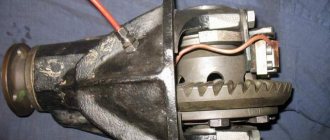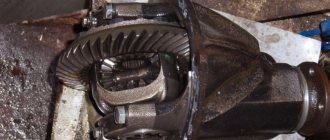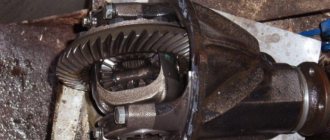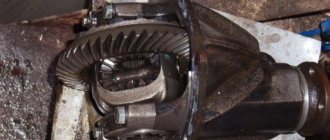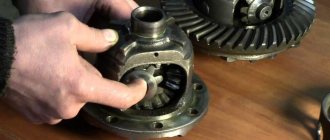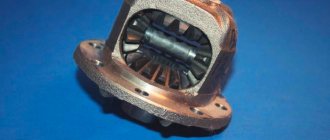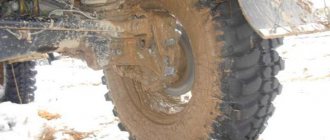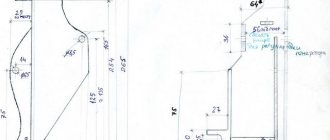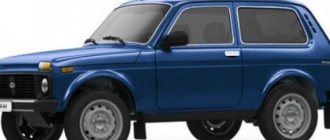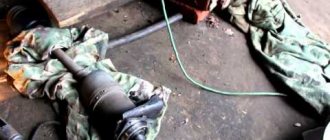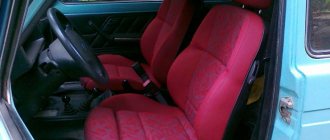Differential purpose
When turning a car, wheels located closer to the center of curvature of the trajectory travel a shorter distance than those rotating in an outer arc. Their speeds are also different. And since a drive without a differential rotates both wheels of the same axle at the same speed, one of them begins to slip. This increases tread wear and worsens vehicle handling. The differential allows the drive wheels to rotate at different speeds.
As long as the drive axle is in good contact with the road, this device works flawlessly. But as soon as the road grip under one of the wheels deteriorates, for example, when it hits ice or liquid mud, only one of them will rotate. A wheel with a high coefficient of adhesion stops spinning and the car stops. If you lock the differential, this will not happen. Therefore, a locked differential improves the vehicle's maneuverability on difficult sections of the road.
If a car has one drive axle, then it also has one differential - between the wheels of this axle. A car with permanent 4-wheel drive has three. One between the wheels of each axle plus one between the axles.
Device
The operating principle of the above-mentioned unit is the same, no matter where it is installed. The classic car differential is based on a planetary gear. The cardan shaft rotates the drive gear of the axle reducer. Its rotation is transmitted to the driven gear. And since it is attached to the differential housing, it moves with it. From the body, the torque is transmitted to the axle shafts using gears independent from each other, called satellites. The rotation speed of the propeller shaft is not equally divided between the axle shafts. However, for any ratio of speeds, their sum is always constant.
- automatic;
- forced, activated by the driver.
By blocking control method:
- mechanical;
- electromechanical;
- hydraulic;
- pneumatic
Automatic differential lock
A self-locking differential is a mechanism that, under certain conditions, switches and, turning into a direct transmission, begins to divide the rotation speed of the driveshaft between the axle shafts equally. Differentials with automatic locking can lock themselves depending on the value of one of two parameters:
- differences in angular velocities of the axle shafts. This group includes differentials with disc locking, cam, viscous coupling and operating according to the Ferguson formula;
- torque transmitted to the axle shafts.
main gear
The main gear is designed to increase the torque transmitted to the drive wheels. Its structure, at first glance, is very simple - two gears. One, smaller in size, is the leader, the second, larger, is the slave. But the design of the main gear largely determines the vehicle’s traction and speed characteristics and fuel consumption.
Hypoid transmission
On rear-wheel drive cars, a hypoid final drive is used, since the torque must be transmitted to the drive wheels at an angle of 90 degrees. Why is a hypoid gear, which is more difficult to manufacture, used, and not a simple bevel gear? Yes, because with a bevel gear, its simplicity is its only advantage. But there are more disadvantages: noise, low load-bearing capacity, high location of the driveshaft (and, consequently, the transmission tunnel in the car body). In a hypoid gear, the axis of the drive gear is offset relative to the axis of the driven gear by the amount of the hypoid offset. Therefore, the driveshaft is located lower, which allows the height of the transmission tunnel to be reduced. This lowers the vehicle's center of gravity, thereby improving its stability.
Gear teeth are made oblique or curved. Due to the fact that in a hypoid gear there are more teeth in mesh at the same time than in a bevel gear, its smooth and silent operation is ensured and the load capacity is increased. However, due to the tighter fit of the teeth, the risk of jamming increases, especially when changing the direction of rotation. Therefore, hypoid gears require high precision adjustment and the use of special gear oil. Anti-wear and extreme pressure additives are added to hypoid gear oils.
In front-wheel drive cars, where there is no need to change the direction of the transmitted torque, simple spur gears are used in the final drive. Structurally, the main gear is installed in a common housing with the gearbox. Spur gears are easy to manufacture, inexpensive, and the risk of scuffing is low. Therefore, in most cases, to lubricate them, not special transmission oil is used, but motor oil.
How does the gear ratio of the main pair affect the traction and dynamic characteristics? The higher it is, the faster the acceleration occurs, but the maximum speed is lower. Conversely, as the gear ratio decreases, the car accelerates more slowly but reaches a higher top speed. The gear ratio for a specific car model is selected taking into account the characteristics of the engine, wheel size, and braking system capabilities.
How to do
The easiest way is to permanently lock the differential completely. But such a homemade blocking is acceptable for cars driving only off-road. For example, for rally-raid cars. To implement the idea, you need to remove the unit equipped with the differential and disassemble it. Then weld the satellites to the axles. Fixing the gears will allow the mechanism to divide the rotation speed between the axle shafts only in a ratio of 50 to 50. Making a limited slip differential with your own hands is a little more difficult than simply fixing the satellites. But such a modernization will not only improve the vehicle’s maneuverability in mud and snow, but will also not change the operation of the unit on hard surfaces. One version of such a device can be assembled from two brass or bronze bushings and a spring. Their sizes will depend on which vehicle transmission you are upgrading. Therefore, work begins with removing the assembly and disassembling the planetary gear. After this, you can take measurements, order the production of bushings and select a spring of suitable dimensions.
You will find out whether it is stiff enough after assembly by testing your homemade product. The spring is designed to press the pinion gears against the differential housing. Because of this, under the influence of friction, the satellites will rotate more slowly around their axis. The greater the friction force, the more evenly the speed of rotation of the driveshaft will be divided between the axle shafts. Metal bushings are needed to prevent contact of the satellites with the spring.
Of course, installing a factory-made differential lock is easier and the result of such an upgrade is better. However, it is expensive and practically eliminates creativity from the process. The cost of “self-blocks” for cars of the VAZ family is slightly less than 12 thousand rubles. But their installation requires only care and accuracy. There is no need for a special tool.
Functional purpose of the device
A rigid blocking is used on the Niva to balance the incoming load. The process is based on the unevenness of the path traveled by each wheel. The sides located closest to the center travel several times shorter than the wheels located on the outer side. At low travel speeds, some of the rubber wears out faster, and at high speeds, skidding occurs.
Electronic differential locking helps to avoid the above. In good condition, it transmits torque from 1 source to 2 different consumers. In order to understand how the mechanism works, it is necessary to imagine the following: from 1 source, each consumer receives a torque of different physical parameters. If the differential lock is set correctly, the difference in the amount of torque received ensures safe rotation of the wheels along the inner and outer radius. Physical wear and tear or mechanical damage increases the likelihood of a skid accident. When operating the VAZ 2121 on roads with unsatisfactory surface quality, the importance of the differential increases.
All-wheel drive vehicles, whose axles are coordinated by a differential, distribute torque evenly to all wheels. In case of slipping, the system automatically transfers maximum torque to them. The switching process does not take much time. In the event of a malfunction, 2 wheels slip, while the other 2 remain stationary. Differential locking helps to avoid this.
It forcibly distributes torque evenly over the front axle, between it and the axles. In case of temporary slipping, the device will provide the necessary uniform force to increase the quality of traction.
Transfer case operating modes
All about mud tires on Chevrolet Niva
This mechanism can operate in five modes:
- Neutral is on.
- The differential is unlocked when the "lowering" is turned off. In this case, the torque is distributed in a ratio of one to two.
- The differential is locked when overdrive is engaged. Here, torque distribution is carried out automatically, depending on the quality of wheel grip on the road.
- Downshift is engaged and the differential lock is disabled. The transfer of forces occurs in the same ratio as in the first case.
- The differential is locked and the gearbox is engaged. In this case, all axles are rigidly locked together, including the axle shafts. Torque is produced unevenly, depending on the type of road surface (dirt, sand, etc.). In this mode of operation, the best cross-country ability of the vehicle is achieved. But driving with a constantly engaged downshift and with locks will not work. This increases the load on the transfer case bearings. The Chevrolet Niva will soon require serious intervention in the transmission. Fuel consumption also increases significantly, which greatly eats up the tires.
Optimization of the technical condition of the unit
The Niva's configuration includes the installation of a differential for driving on roads with standard surfaces. If the “iron horse” is intended to be used as an SUV, then modifications will be needed. Under standard operating conditions on the Niva, torque is automatically supplied to the axis where there is a lack of torque. For comfortable off-road driving, it is necessary to transmit torque to all wheels in an equal amount.
It will help to become familiar with how to use the torque transfer case. If you have the necessary knowledge, optimization is carried out in-house. The technically correct scheme of actions is as follows:
- Installation of a forced system operating in automatic mode. Its strengths include its ability to withstand the test of severe off-road conditions. A forced differential locking system is installed only if the vehicle is used most of the time on roads with unsatisfactory surfaces.
Experienced drivers recommend following these tips. If you install the system without taking into account the specifics of movement, then there is a high probability of increased wear of the vehicle’s chassis. It would be useful for those who are just planning to acquire a personal car to understand the difference between the two concepts.
The interwheel unit of the Niva Chevrolet transmits torque between the left and right wheels. The system only works within the bridge where it was installed. The interaxle block of the car is a dynamic transfer of torque between the rear and front axles.
In the “default” mode, the manufacturer installs only one type of differential lock on manufactured vehicles. Before purchasing, you must clarify this detail using the technical description. It must be remembered that using everything at once is strictly prohibited. A Chevrolet Niva car provides for the safe use of only one type of lock.
Types of devices and technical specifications
Taking into account the design features, there are 2 types of self-locking differential. The DAK model (Krasikov automatic differential) belongs to the first category, and the “Togliatti” model belongs to the second category. The name itself says that the first option is used more often on foreign-made machines. There are certain differences in the financial component.
That is why when choosing a cross-axle differential you need to be guided by financial capabilities and the desired result. By default, the device is installed on the rear axle. Installation on the front wheel control element is allowed, but in this case the load on the steering wheel will increase significantly.
Using the power steering (power steering) system will become impossible. As soon as the power steering is turned on, the functioning of the self-locking device becomes more complicated. Studying the features of each locking system will help you avoid many problems:
History of ways to solve the problem of a slipping wheel
- 1825 - Onesiphore Pecqueur (1792-1852)
invented the differential. - 1932 - Ferdinand Porsche began research into slip differentials.
- 1935 - collaborating with Porsche, launched a cam differential, which was subsequently used on early Volkswagen models (Type B-70)
- 1956 - the American company Packard was one of the first to begin producing models with a differential under the brand name “Twin Traction”. In the 60s, many companies began producing LSD differentials under various brand names:
- Alfa Romeo: Q2
- American Motors: Twin-Grip
- Buick: Positive Traction
- Cadillac: Controlled
- Chevrolet/GMC: Positraction
- Chrysler: Sure Grip
- Dana Corporation:Trak-Lok or Powr-Lok
- Ferrari: E-Diff
- Fiat: Viscodrive
- Ford: Equa-Lock and Traction-Lok
- International: Trak-Lok or Power-Lok
- Jeep: Trac-Lok (clutch-type mechanical), Tru-Lok (gear-type mechanical), and Vari-Lok (gerotor pump), Power Lok
- Oldsmobile: Anti-Spin
- Pontiac: Safe-T-Track
- Porsche: PSD (electro-hydraulic mechanical)
- Saab: Saab XWD eLSD
- Studebaker-Packard Corporation: Twin Traction
Self-installation of the mechanism
As mentioned earlier, it is necessary to install a differential on a Niva yourself, taking into account the class of the road, the type of vehicle and the degree of its wear. To work you will need to drive onto an overpass. This is easy to find in a garage cooperative. Before starting work, you must make sure that the diagram with the technical description is in front of your eyes (IMAGE 1).
From the theoretical part you need to move smoothly to the practical. To work you will need a standard set of tools. Using wrenches and a screwdriver, the self-locking differential is unscrewed. After this, a visual inspection of the area is carried out. The presence of minimal chips or signs of physical wear on the front part or rear element requires preliminary technical replacement.
Once everything is ready, the surface is treated with anti-corrosion treatment. A new self-block that has passed preliminary testing is installed. After installation, you need to check how successfully partial or complete blocking is activated.
A properly organized locking system is used to increase the transmission of torque to the front or rear wheels.
This helps when slipping and for off-road driving. Regular maintenance will ensure safe operation of the vehicle and reduce the likelihood of skidding. You can eliminate any malfunctions yourself or by contacting a service station.
7. Distribution of torques in the transfer case
The question comes up quite often. Misunderstanding arises due to the fact that completely different physical phenomena are confused: force (moment) and motion (rotation).
First, a few starting points.
1. An unlocked symmetrical differential distributes the torque coming from the input shaft to the output shafts exactly equally: 50/50. This follows from the fact that the gear ratios from the input shaft to the output shaft are the same. In this case, the output shafts can rotate at different speeds, but the average speed (half the sum of the speeds) is equal to the speed of the input shaft divided by the gear ratio.
2. A locked differential ceases to be a differential. The movement (rotation) of the input shaft is transmitted equally to the output shafts. The speeds of the output shafts are equal to each other, and their sum is equal to the speed of the input shaft divided by the gear ratio.
3. If the total torque applied to the shaft (wheel) is not zero, the rotation will be accelerated or decelerated. This is Newton's second law. If the shaft or wheel rotates uniformly, the total torque acting on it is exactly zero. The absence of movement is also uniform rotation, but with zero speed.
There are three symmetrical differentials in the field. When they are all unlocked, each wheel receives 25% of the torque transmitted through the transmission from the engine. And the rotation generated by the engine is also transmitted to all four wheels, but not necessarily equally. For example, when turning, the rear wheels travel a shorter distance (smaller radius) than the front wheels, but all four wheels pull equally.
Let's consider a situation where one wheel is slipping, the rest are standing. All engine rotation is transmitted to the slipping wheel. Strange as it may seem at first glance, the slipping wheel accounts for 25% of the torque, exactly the same as the rest. But this moment is small: it is equal to the moment of friction (only in the transmission, if the wheel is completely suspended). This means that the moment on the other wheels is also very small, it cannot move the car. The car is stationary, and the suspended wheel rotates at a speed that is four times higher than it would be during normal movement at speed at the same engine speed and with the same gears in the gearbox and transfer case.
Now let's turn on the center differential lock. The rotation speeds of the cardan shafts are forcibly equalized. The total speed of the front wheels should be equal to the total speed of the rear wheels.
Forced differential locking on Niva
What is a differential lock in a field? The center differential is good. But conditions may arise under which only one wheel out of four will rotate. What's the point of all-wheel drive? Tolyatti designers foresaw this. The Niva is equipped with a forced locking of the center differential. This means that the driver, if necessary, can equalize the speeds of both axles. Thus, one wheel will constantly rotate on different axles, as a result, the vehicle’s maneuverability is significantly increased. But forced locking can only be used off-road. By the way, some drivers do not really delve into the design of the Niva and mistakenly believe that by switching the small lever back, they engage the front axle. No, this handle just blocks the center differential.
For reasons of cross-country ability, it would be very good if all 4 wheels rotated, even for a short time. In this case, the car would be little inferior to the tractor. But the Niva has a so-called free inter-wheel differential, i.e. torque is alternately supplied to one of the wheels and forced locking is not provided for the Niva.
Moreover, the Chevrolet Niva does not have such a block either.
Buying hand winches for cars: secrets of selection.
Are you thinking about tuning the Toyota Land Cruiser Prado 150 for different situations? This material will help you with this.
The best mud tires for Niva and other SUVs: how to choose the right one.
The American concern liked the transmission so much that they transferred it to the joint car with almost no changes. “Almost” - because GM designers combined control of the transfer case and forced differential locking. The result is two levers instead of three. Patriotic owners of domestic SUVs, by the way, consider the convenience of such innovation doubtful. Another change affected the mounting of the transfer case. Thanks to its new supports, vibration in the cabin has become much less.
Assembly of the unit
When you have decided on the best self-locking differential for the Niva, you can begin assembling the unit. Initially, they adjust the gaps, which is not so simple. For this purpose, special washers of different thicknesses are used. Alternatively, accuracy is determined using a steelyard. One edge of the cord (about a meter in length) is wound around the flange, and the second is fixed to the scales. Pull the device in the winding, not forgetting to mark the turning point.
To ensure correct functioning of the gearbox, the elements are sealed before assembling the parts. If this is not done, soon after installation defects may appear, even to the point of complete breakdown of some parts. After treating the surfaces with sealant, wait until it dries completely. Next, the gearbox is filled with new oil. All sealing components with deformations and a hint of leakage are replaced. The mechanisms are assembled in a mirror order. After the replacement and installation of parts is completed, you should check the operation of the brake unit. This is very important, since malfunction of parts affects road safety.
Forced locking of the cross-axle differential on Niva
The VAZ SUV was developed as a car for the village. At the time, it was said that additional interlocks would complicate the design, making it more expensive and less reliable. In addition, the Niva already has good cross-country ability. This is probably correct. However, in a country where the percentage of paved roads out of the total number is relatively small, we want more.
Various small and large enterprises took advantage of this, mastering the production of differentials with forced locking. The following should be noted immediately . Therefore, before converting a car, you need to weigh everything carefully and be sure to consult with specialists.
And, nevertheless, since such a rework is possible, it is necessary to say a few words about it. Currently, the most common differentials are:
- With pneumatic connection;
- With electrical connection;
- Self-locking.
Briefly - the advantages and disadvantages of each of them.
Pneumatic connection.
The wheels are locked from inside the car using compressed air. In this case, a silicone hose is laid to the car axle. The device is quite reliable, but requires additional expensive equipment. A set of hoses, a compressor and a receiver are sometimes more expensive than the differential itself.
Electrical connection
The differential gear is locked by a cam mechanism, which is activated by electromagnets. The device is reliable and does not require maintenance. The downside is the high current consumption, which places additional demands on electrical equipment.
Self-locking mechanisms
Their operating principles are different. Some are blocked at the slightest slip, others when the load on the wheels increases. However, regardless of the design, they do not require human intervention, and therefore are popular among SUV owners. But their main advantage is that they do not have such a rigid locking as all other types, which means they partially remove additional load from the axle shafts.
